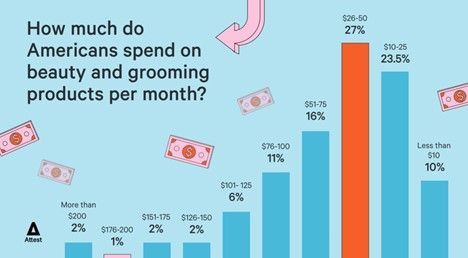Americans Adopt A Low-Maintenance Approach To Grooming After COVID-19
With the worst of the coronavirus pandemic seemingly behind us, Americans are gradually adapting their habits to the new "normal." The world will never be quite the same again, and it seems that one of the many things that we're taking an entirely new approach to is how we present ourselves.
A survey of 2,000 nationally representative consumers found that the pandemic's effect has had a lasting impact on how the public views and maintains personal appearance. Three-quarters of Americans are spending less than half an hour on beauty and grooming every day, according to Attest's US Beauty & Grooming Report 2022 Report. More than a quarter of men — 28.2% — say they spend less than 15 minutes on their daily personal care regime, while 34.8% of women said that they spent 30 minutes.
The number of beauty and grooming products that Americans use on a daily basis reflects the stripped-back approach taken by the majority of respondents. While 40.3% of women said they used between four and six products, less than 9% used more than 10 products. The majority of men — 54.7% — said that they only used between one and three products on a daily basis, with just under 15% using seven or more.
Mask mandates in public, mask treatments in private
This low maintenance approach can be explained by the shift to home- and hybrid-working models adopted by many US businesses during the pandemic. With people more likely to be spending an increased amount of time at home, and wearing masks when out and about, it seems that personal appearance became less of a priority for many Americans.
Another effect of restrictions was that most Americans had to take responsibility for personal grooming into their own hands as they were unable to visit beauticians, barbers, hairdressers and the like. According to the data, 85% of Americans carry out beauty treatments at home, with face masks (not the N95 type!) and facials the most popular treatment — undertaken by nearly four in 10 respondents.
A third of Americans are cutting their hair at home, while 32% are performing their own coloring treatments as well. Almost half of men (45%) said they now cut their hair at home, compared to 21% of women. Other popular DIY beauty care activities include manicures or pedicures (31%), and shaping eyebrows (25%).
Americans still want to buy beauty products in store
But while these activities are taking place largely at home, one of the more surprising findings of the research was that when it comes to buying beauty and grooming products most respondents largely favor the in-store experience. While e-commerce experienced an unprecedented boom during the pandemic, it seems American consumers would still rather make this type of purchase in person. Of course, many of these products are things that can be sampled in a physical store, whether it's trying out a certain shade of eyeshadow, or smelling an aftershave to see if you like the fragrance or not.
It makes sense, then, that the preferred place to buy fragrances, skincare and make-up among respondents was a department store — where samples and advice from staff are often available — while most Americans want to buy haircare and shaving products from a supermarket. Around 10% of consumers shop in a discount store for all their beauty and grooming product needs, with women almost twice as likely to make a purchase from these sources than men.

This suggests that there is a significant degree of price consciousness among consumers when it comes to beauty and grooming products — indeed, six out of 10 spend less than $50 a month on products in this category — however, there isn't quite the same level of eco-consciousness. While just over a quarter take a brand's green credentials into account when making their purchasing decisions, twice this number (52%) say that they are more interested in buying products with "clean" or "natural" ingredients.
HIBAG Millennials bucking the trend
However, as is often the way, it's the outliers and those who go against the grain that make for some of the most interesting findings in the research. Around 12% of the overall sample are spending more than $100 per month on beauty and grooming products — compare this to the 27% who spend between $26 and $50, and the 23.5% who spend between $10 and $25. These Highly Invested in Beauty and Grooming (or HIBAGs, as we call them) individuals are slightly more likely to be male than female, and mostly within the Millennial age range of 26 to 40 years old. They over-index for shopping weekly across every category, including makeup, haircare, skincare, fragrance and shaving.

Overall, though, it seems that personal grooming is something that many Americans are approaching in a completely different way since the coronavirus pandemic. It remains to be seen whether these trends continue, but for now low-maintenance, low-cost and home-based treatments seem to be the order of the day.
(Jeremy King is the CEO and founder of Attest)
© Copyright IBTimes 2025. All rights reserved.





















